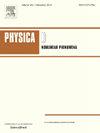一种基于高阶双耦合duffing振荡器、经验小波变换和希尔伯特变换的水下微弱信号检测方法
IF 2.9
3区 数学
Q1 MATHEMATICS, APPLIED
引用次数: 0
摘要
随着海洋噪声环境的日益复杂和隐身技术的进步,水下信号的连续频谱明显减弱,传统的随机信号分析方法已无法适应复杂噪声背景下的微弱信号检测。为了解决超低信噪比(SNR)下水下微弱信号检测的挑战,我们提出了一种集成高阶双耦合Duffing振荡器、经验小波变换(EWT)和希尔伯特变换的新型检测方法。该方法首先引入了一种新型的高阶双耦合Duffing振荡器,其动态行为使用非线性技术进行了彻底分析,包括李雅普诺夫指数,分岔分析和熵测量。分析表明,改进的Duffing振荡器对不同噪声具有良好的鲁棒性。然后,结合所构造的几何频率阵列和尺度变换,构造了一个可以检测任意频率的弱信号检测阵列。该系统通过监测吸引子轨迹的变化,特别是从混沌行为到大周期或间歇性混沌的转变,来识别水下信号的存在。最后,提出了一种利用EWT和Hilbert变换的频率提取方法,对间歇性混沌信号进行降噪和峰度优化,从而提取水下微弱信号的实际频率。实验结果表明,该检测阵列能够有效识别淹没在复杂噪声环境中的水下微弱信号,检测信噪比为-38.42 dB,提取信号频率误差为<; 1%。仿真结果满足水下声纳应用对精度的严格要求。本文章由计算机程序翻译,如有差异,请以英文原文为准。
A novel underwater weak signal detection method based on High-order double-coupled duffing oscillator, Empirical wavelet transform and Hilbert transform
The increasing complexity of marine noise environments and advancements in stealth technology have significantly weakened the continuous spectrum of underwater signals, rendering traditional random signal analysis methods inadequate for weak signal detection amidst complex noise backgrounds. To address the challenge of detecting underwater weak signals at ultra-low Signal-to-Noise Ratios (SNR), we propose a novel detection method that integrates high-order double-coupled Duffing oscillator, Empirical Wavelet Transform (EWT), and Hilbert Transform. This approach begins with the introduction of a novel high-order double-coupled Duffing oscillator, whose dynamic behavior is thoroughly analyzed using nonlinear techniques, including Lyapunov exponents, bifurcation analysis, and entropy measures. The analysis proves that the improved Duffing oscillator has excellent robustness to different noise. Then, combined with the constructed geometric frequency array and the scale transformation, a new weak signal detection array that can detect any frequency is constructed. The system discerns the presence of underwater signals by monitoring changes in the attractor trajectory, specifically transitions from chaotic behavior to large-period or intermittent chaos. Finally, a novel frequency extraction method that leverages EWT and Hilbert Transform is proposed, which can achieve noise reduction and kurtosis optimization for intermittent chaotic signals, thereby extracting the actual frequency of underwater weak signals. Experimental results confirm that the proposed detection array effectively identifies underwater weak signals submerged in complex noise environments, achieving a detection SNR of -38.42 dB and an extracted signal frequency error of <1 %. The simulation results meet the stringent accuracy requirements for underwater sonar applications.
求助全文
通过发布文献求助,成功后即可免费获取论文全文。
去求助
来源期刊

Physica D: Nonlinear Phenomena
物理-物理:数学物理
CiteScore
7.30
自引率
7.50%
发文量
213
审稿时长
65 days
期刊介绍:
Physica D (Nonlinear Phenomena) publishes research and review articles reporting on experimental and theoretical works, techniques and ideas that advance the understanding of nonlinear phenomena. Topics encompass wave motion in physical, chemical and biological systems; physical or biological phenomena governed by nonlinear field equations, including hydrodynamics and turbulence; pattern formation and cooperative phenomena; instability, bifurcations, chaos, and space-time disorder; integrable/Hamiltonian systems; asymptotic analysis and, more generally, mathematical methods for nonlinear systems.
 求助内容:
求助内容: 应助结果提醒方式:
应助结果提醒方式:


